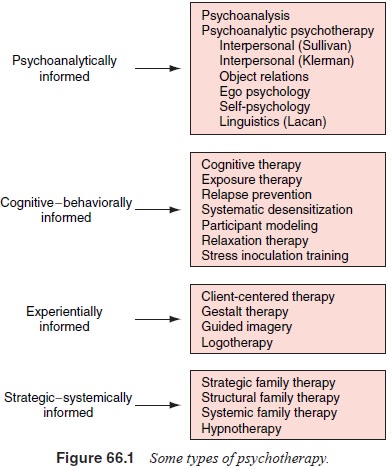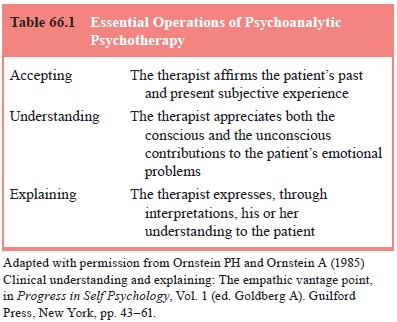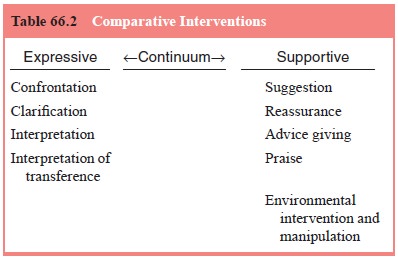Chapter: Essentials of Psychiatry: Individual Psychoanalytic Psychotherapy
What is Psychoanalytic Psychotherapy?
What
is Psychoanalytic Psychotherapy?
It is
customary to define psychotherapy in a broad fashion as being composed of three
distinct components: a healing agent, a sufferer and a healing or therapeutic
relationship (Frank and Frank, 1991). Strupp (1986) specified that
psychotherapy is the systematic use of a human relationship for therapeutic
purposes of alleviating emotional distress by effecting enduring changes in a
patient’s thinking, feelings and behavior. The mutual engagement of the patient
and the psychotherapist, both cognitively and emotionally, is the foundation
for effective psychotherapeutic work.
Whereas
there are many different types of psychotherapy (Figure 66.1), the core task of
the psychoanalytic psychothera-pist is to make contact with and comprehend, as
thoroughly as possible, the patient’s subjective inner world to engage in an
analytical (i.e., interpretive) conversation about it (Ornstein and Kay, 1990).
This core task implies that all psychoanalytic psy-chotherapies may be further
defined in terms of three operations: accepting, understanding and explaining
(Ornstein and Ornstein, 1985) (Table 66.1). First, and more specifically, the
therapist must engage with the patient by accepting the subjective experience
of the patient’s emotional pain and conflict. This is achieved through the
establishment of a therapeutic dialogue based on an empathic, nonjudgmental
rapport. Secondly, within the process of listening to, and feeling with, the
patient, the therapist will be-gin to develop an understanding of the
intricacies of the patient’s plight. Much of what the therapist observes may at
first remain outside of the patient’s conscious awareness, manifested in the form
of reenactments and reliving of earlier experiences withinthe therapy, rather
than in deliberate, conscious, descriptive com-munication. Last, by the sharing
of this beginning understanding with the patient through a simultaneously
empathic and interpre-tive mode, both arrive at a deeper appreciation for the
genesis of, and the reasons for, the patient’s symptoms. The shared
relation-ship in which understanding is gained is no less instrumental in
achieving change than are the insights and modified perceptions that may result
from the psychotherapeutic experience.


It is
appropriate to conceptualize psychoanalytic psycho-therapy as being on a
continuum of expressive to supportive (Luborsky, 1984; Gabbard, 1994).
Traditionally, to the degree that psychoanalytic psychotherapy has focused on
the recovery of repressed psychological material, it has been called
“expressive” and has been distinguished from the supportive psychotherapies
which have concentrated on the shoring up of certain defense mechanisms. This
implies that any given treatment might employ more or less expressive and
supportive interventions, depending on what is transpiring within the
psychotherapeutic process. An important skill of the psychoanalytic
psychotherapist is then the ability to employ the appropriate balance of both
expressive and supportive interventions as dictated by the needs of the
patient. Finally, the conceptualization of an expressive–supportive con-tinuum
also facilitates the establishment of therapeutic goals, in-terventional plans
and indications for individual psychoanalytic psychotherapy (Gabbard, 1994)
(Table 66.2).

The
theoretical concepts that derived from the theory reviewed constitute, more or
less, the assumptions behind all psychoanalytic psychotherapy. These include,
most im-portantly, the role of the unconscious; the centrality of
transfer-ence; the characterological defense mechanisms; and the resistance to
self-awareness and thereby to progress in the therapeutic setting. Of secondary
importance, but nevertheless closely related to the unconscious, is the concept
of psychic determinism, namely, that people behave in specific ways for
specific reasons. No experience or memory, according to psychoanalysis, is ever
lost but resides in the unconscious, which continues to influence current and
future ways of experiencing feelings, thoughts and behaviors. Advances in
cognitive neuroscience have supported the notion that many sig-nificant
experiences throughout life remain outside of awareness.
Related Topics